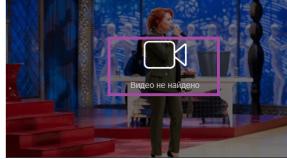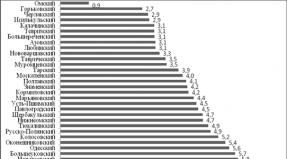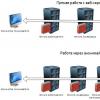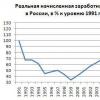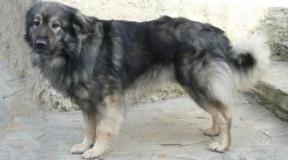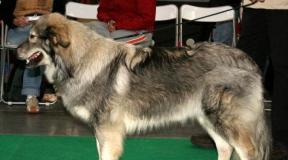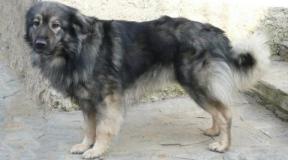Prevention of overheating. Overheating of the body of the victims of disaster during their location in the ocean on rescue rates, treatment and prevention. Overheating and breathing
One of the essential events Anti-overheating in hot shops is a rational drinking mode. Abundant drinking fresh water, as already mentioned, strengthens the sweating and thereby increases the amount of salt from the sweat. Adding to the water of a table salt from 0.2 (depending on the amount of sweat lost) to 0.5% contributes to the restoration of the water-salt balance.
It decreases thirst, the release of sweat and weight loss, improves well-being and increases productivity. Sliced \u200b\u200bwater is gasped. This gives it a pleasant taste and helps to improve the secretion of gastric juice, since carbon dioxide acts as an exciting way to the gastric mucosa. Simultaneously with salted water in hot shops, it is necessary to have for those who want fresh water.
Available in literature Indications for selection with then water-soluble vitamins and to increase the metabolism in the body at high ambient temperature (starting from 35 °) justify, apparently, use as a drink for workers hot shops of a vitamin beverage (yeast kvass). The favorable effect of this drink in the context of production is confirmed by special observations of researchers of the Kiev Institute of Labor Hygiene and professional diseases.
For preventing organism overheating Large importance has short-term breaks in work or a longer subservation time. The latter are especially necessary with such stress processes as the repair of Marten and other metallurgical stoves, rolling, rolling, heavy stamping and forging, fill large forms, etc.
Introduction breaksMoreover, the submenu contributes to the restoration of equilibrium and heat-regulation mechanisms, especially if the worker conducts these interruptions in normal meteorological conditions. For example, at the air temperature at the place of recreation, the workers at 19 ° pulse falls after 8 minutes from 175 to 100 shots per minute; If the rest occurs at the air temperature of the air, the pulse frequency during the same time decreases only 28 shots. A similar picture is observed in relation to the body temperature.
On some metallurgical industry enterprises Equipped special radiation cabins, or recreation rooms, in which workers conduct short-term (15-20-minute) breaks. They are intended mainly for the warm period of the year and are arranged directly in the workshop or in the premises adjacent to it. Two walls of such a cabin - recreation rooms - cooled by coils, in which the brine coming from the refrigeration unit is circulated.
Radiation cabins Designed for staying one or more people. Recreation rooms with cooled panels are designed for a more significant number of workers. For them, the following options for meteorological parameters are proposed.
1. The temperature of the walls and air in the cab 15-17 °.
2. The temperature of the walls in the cab 10-14 °, air 25-30 °.
3. The temperature of one wall in the cab 1 °, the remaining walls and air 25-30 °.
4. The temperature of the walls is 20 °, the air temperature is 28 ° (for the conditions of a very hot climate).
Currently cabins Radiation cooling with specified temperatures of walls and air and recreation rooms with cooled panels are provided in the projects of gypsum and a promstroyprocket for hot shops of ferrous metallurgy. As for recreation rooms with chilled walls, equipped already on some operating enterprises of ferroalloys, in particular, in the Chelyabinsk Ferroalloy Plant, then, according to the observations of the Institute of Labor Hygiene and Professional Diseases, Staying in them occurs within 15-20 minutes.
Without cooling Full restoration walls of physiological reactions are not observed until the end of the break.
At the same time quick transition of dried smelters From the furnaces in the room with cooled walls does not cause cold illnessSince the workers are removed at the same time only excess heat and the body undercooling occurs. A favorable action is also provided by hydroprocessors in the form of the seedless, installed near the workplace. Significantly protects against overheating and rational overalls, manufactured from air and paravertible tissues, which has thermal protection properties and having a free cut.
Prevention of overheating of the body is carried out by restricting the flow of heat into the premises and exposure to working, effective ways Road, rationalization of labor and recreation modes, drinking mode, clothing.
Mechanization of labor processes and the use of more advanced equipment types reduce heat intake into the working area. Examples are the use of electric furnaces in steel production, machine forging metal instead of manual, mechanized loading of furnaces in metallurgy, loading products in drying chambers and removal of them, cooling hot products in separate rooms. The mechanization of work, alleviating, reduces the energy produced, thereby reducing the possibility of overheating the body.
The remote control of the workforce increases the distance between the working and heat source, which reduces the intensity affecting the radiation person. The removal of equipment for open areas in the chemical and other industries in some cases also leads to a decrease in heat dissipation in the workshops and the overheating of the body.
In the removal of excess heat from the room, rational ventilation is played in the prevention of overheating of the body - mechanical and especially natural (aeration). To create a normal in separate workplaces and zones, air souls and oasis are arranged. On a number of production, air conditioning is widely used.
The rationalization of labor and recreation modes is carried out by reducing the working day, the introduction of additional interruptions, creating conditions for effective rest. In our country, for many professions in the "hot" shops have been installed 6-hour working day. In the summer, it is advisable to start work in the early hours, and during a multi-permissive work a hot period (from 12 to 16 h) must be evenly distributed between shifts. The frequency and duration of additional (except dining) breaks are established on the basis of physiological studies. They should have a duration sufficient to remove signs of fatigue and normalization of thermoregulation processes.
During rest, the worker should be indoors with normal microclimatic conditions, special seats, chairs, leisure chairs. In some cases, such rooms are equipped with radiation cooling panels having a temperature of 0 to -5 ° C. Radiation cooling screens or cooled walls, floor, ceiling can also be used in the working area: indoors for control panels, administrative staff (in hot climate conditions), etc.
If the rest can not be organized in a separate room, near jobs are created by recreation areas - "oasis", where the measure of ventilation is maintained by the normal temperature and air mobility. Additional events for rapid removal of excess heat from the body are wetting clothes, water procedures (2-3 times during the shift). For this purpose, near workplaces are installed.
An important role in the prevention of the organism overheating during short-term work in conditions of very high temperatures is played by thermal training. Such work includes the repair of metallurgical furnaces, the elimination of underground fires by the mountains. The air temperature can reach 80-100 ° C and more. Resistance to high temperatures can also be increased inhalation of oxygen, introducing some medicines. However, the main role in overheating protection in such cases belongs to the means of individual protection (overalls, sweaters) and restricting the time of stay in such conditions.
Rational drinking mode is necessary to compensate for loss of moisture, salts, vitamins. With a loss of body weight, reaching 4-4.5 kg in shift, the workers of hot shops should be provided by the cooled salted carbonated water (0.5% sodium chloride solution). With a loss of body weight up to 3-3.5 kg in shift, sodium chloride is additionally introduced into the diet, the workers are provided with chilled carbonated water, sometimes hot tea and other drinks that have a tonic effect on the body and compensate for the loss of vitamins.
In the prevention of overheating and the unfavorable effect of thermal radiation on the head and eyes, individual means of protection play a large role. Overalls should have a spacious and comfortable cut, and fabrics are not imperative to evaporate and convection. These requirements are subject to cotton, linen and wool fabrics (cloth). To protect against thermal radiation, reflective tissues are used, on the surface of which a thin layer of metal is sprayed, usually aluminum reflecting the main part of the falling on them. Overalls should be durable, it is necessary to control its condition - timely washing, repair, replacement on time.
To protect the head against heat radiation, fiber and duralumin helmets are used, wide-grade felt hats, and glasses (dark or with a thin transparent metal layer), headless masks with folding screens. Selection of light filters for various works is determined by special gtales.
When opening operations for the prevention of overheating of the body at regular workplaces, it is necessary to install canopies, and in the places of periodic stay - movable awnings that protect against solar radiation. Cabs of machines are painted in light tones, equipped with thermal insulation materials, and sometimes air conditioners. Places for recreation are located near the jobs, shelter from the sun and wind, equipped with shower plants, install couches, chairs. There must always be chilled water and hot tea.
Industrial Sanitation and Labor Hygiene
The effect of heating microclimate on physiological functions organism. Prevention of the organism overheating.
The human activity can normally proceed only if the organism's temperature homeostasis is preserved, which is achieved at the expense of the thermoregulation system and the activities of other functional systems: cardiovascular, excretory, endocrine and systems providing energy, water-salt and protein exchange. To preserve the constant body temperature, the body must be in a thermostable state that is estimated on the thermal balance. The thermal balance is achieved by coordination of heat-flow and heat transfer processes.
High air temperature contributes to the rapid fatigue of the working, can lead to the overheating of the body, thermal impact. The heating microclimate can lead to a common disease that manifests itself most often in the form of a thermal collapse. It arises due to the expansion of the vessels and reduce the pressure in them. In this case, the body temperature is not too high. Trimming state preceded by headache, feeling of weakness, dizziness, nausea. The skin will first blush, then pale and covered with cold sweat. Cardiac frequency increases. This condition quickly passes upon rest in a cool place. The intensive sweating occurring in these conditions is accompanied by losses of salts and water in the body. The amount of blood platelets and its viscosity increases, the level of cholesterol in the blood plasma, which increases the likelihood of thrombosis (in particular, the brain arteries). The incidence of hot workshops is 1.2 - 2.1 times higher than among workers who are not subjected to the permanent action of the heating microclimate. The thermal load in the basic workshops of metallurgical production causes 37% of all diseases of the respiratory organs and 39% of digestive diseases. There are diseases of the cardiovascular system associated with a significant hemodynamic stress that are manifested in the form of persistent myocardiopathies, neurocirculatory dystonium by hypertonic type. There is an intensive biological aging of workers whose work is associated with significant thermal and exercise, especially in the age group of 50 years. Headaches are observed, increased sweating and fatigue. Revealed a reliable increase in standardized mortality rates from diseases of the cardiovascular system.
As a result of the solar strike, the heartbag functions are primarily disturbed due to the local head overheating. To heat depletion can be reduced by moisture in the body. Reducing the moisture content in the human body by 1 - 2% of the total mass does not lead to any significant changes in the body (except for the occurrence of thirst). With the enhancement of dehydration of the body, such phenomena as drowsiness, uncombound movements and a significant decrease in performance occur. With a deficiency of moisture, more than 10% of the body weight comes the loss of consciousness, sometimes - the state of strong arousal and death.
Cooling microclimate - a combination of parameters in which the total heat transfer to the environment exceeds the body's heat product. This leads to the formation of the general and (or) local deficit of the heat in the human body (\u003e 2 W).
The heating microclimate is a combination of parameters in which the change in the human heat exchange with the environment is occurring, manifested in the accumulation of heat in the body (\u003e 2 W) and (or) in increasing the share of heat losses by evaporation of moisture (\u003e 30%).
The microclimate in industrial premises is formed under the influence of the following factors:
Availability of heat generation sources (including working personnel);
Heat gain from solar radiation;
Heat generation when operating electrical equipment;
The multiplicity of air exchange indoors;
Heat transfer through enclosing structures;
Temperature surfaces of equipment and enclosing structures.
Prevention P. Oh. includes a set of activities aimed at protecting workers from heat dissipation sources, the organization of a rational routine of the day, medical control For working, drinking mode and nutrition. Water consumption should be sufficient for quenching thirst; The most appropriate is fractional water intake. With a loss of more than 4-4.5 kg The mass of the body for the working shift is recommended additional reception of the cook salt. Working in high temperatures is desirable to limit the reception of oily food, reduce the calorieness of lunch, increasing the calorie content of dinner and breakfast: carbohydrate and carbohydrate-protein food is preferred. To protect against the adverse effects of high temperatures, a short-term rest in places protected from direct solar irradiation, close to the place of work (under a canopy, awning, in a portable house or autofur, which are equipped with fans, air conditioning, shower plants). Working should be provided in sufficient drinking water, vitamined drinks, as well as air-permeable and vapor-permeable overalls and headdress. It is advisable to work outdoors to plan on the cool morning and evening hours, and the hottest time to get out for recreation and work in cool rooms. For prevention P. o. In production conditions with high temperatures, water spraying and air blowing is recommended. Recreation rooms should be equipped with air conditioning, cooling and (or) ventilation.
2. Electromagnetic fields. Sources. Methods and means of protection.
Electromagnetic fields
In practice, when characterizing the electromagnetic situation, the terms "electric field", "magnetic field", "electromagnetic field" are used. Briefly explain what it means and what communication exists between them. The electric field is created by charges. For example, in all known school experiments by electrifying an ebony, there is a electric field.
The magnetic field is created when the electrical charges are moved over the conductor. For the characteristics of the electrical field, the concept of the electric field strength, designation E, unit of measurement in / m (volt-na-meter) is used. The magnitude of the magnetic field is characterized by the tension of the magnetic field H, a unit of a / m (amp on-meter). When measuring ultra-low and extremely low frequencies, the concept of magnetic induction B is often used, a unit of TL (Tesla), one millionth of the TL corresponds to 1.25 cars.
By definition, the electromagnetic field is a special form of matter by which the effect is carried out between electric charged particles. The physical reasons for the existence of the electromagnetic field are associated with the fact that the electric field-varying electric field E generates a magnetic field H, and the changing H is a vortex electrical field: both components E and H, changing continuously, excite each other. EMF fixed or evenly moving charged particles is inextricably linked with these particles. With an accelerated movement of charged particles, EMF "breaks off" from them and exists independently in the form of electromagnetic waves, not disappearing with the elimination of the source (for example, radio waves do not disappear and in the absence of current in the radiating antenna).
Electromagnetic waves are characterized by a wavelength, designation L (lambda). The source generates radiation, and in essence creates electromagnetic oscillations, are characterized by a frequency, the designation - f. An important feature of EMF is dividing it on the so-called "near" and long zone. In the "near" zone, or induction zone, at a distance from the source R< l ЭМП можно считать квазистатическим. Здесь оно быстро убывает с расстоянием, обратно пропорционально квадрату r -2 или кубу r -3 расстояния. В "ближней" зоне излучения электромагнитная волне еще не сформирована. Для характеристики ЭМП измерения переменного электрического поля Е и переменного магнитного поля Н производятся раздельно. Поле в зоне индукции служит для формирования бегущих составляющей полей (электромагнитной волны), ответственных за излучение. "Дальняя" зона - это зона сформировавшейся электромагнитной волны, начинается с расстояния r > 3l. In the "Further" zone, the field intensity decreases inversely in proportion to the distance to the source R -1.
In the "long" zone of radiation there is a connection between E and H: E \u003d 377n, where 377 wave resistance of the vacuum, Ohm. Therefore, it is usually measured, only by E. In Russia at frequencies above 300 MHz, the density of the electromagnetic energy flow (PPE) is usually measured, or the porting vector. Denotes as s, a unit of measurement W / m2. PPE characterizes the amount of energy carried by the electromagnetic wave per unit of time through the unit of the surface, perpendicular to the direction of the wave propagation.
2. The impact on the human body
In the USSR, broad studies of electromagnetic fields were started in the 60s. A large clinical material was accumulated on the adverse effects of magnetic and electromagnetic fields, it was proposed to introduce a new nosological disease "radio wave disease" or "chronic damage to microwaves". In the future, the works of scientists in Russia were established that, firstly, the human nervous system, especially the highest nervous activity, is sensitive to EMF, and, secondly, that EMF has the so-called. An informational action when exposed to a person in the intensities below the threshold magnitude of the thermal effect. The results of these works were used in the development of regulatory documents in Russia. As a result, the standards in Russia were installed very rigid and differed from American and European several thousand times (for example, in Russia, I remove 0.01 MW / CM2 professionals; in the United States - 10 MW / cm2).
Biological effect of electromagnetic fields
Experimental data from both domestic and foreign researchers indicate the high biological activity of EMF in all frequency bands. With relatively high levels of irradiating EMF, modern theory recognizes the thermal mechanism of impact. With a relatively low level of EMF (for example, for radio frequencies above 300 MHz, this is less than 1 MW / cm2) It is customary to talk about the neutpel or informational nature of the impact on the body. The mechanisms of action of the EMF in this case are still little studied. Numerous studies in the field of biological effects EMF will determine the most sensitive human body systems: nervous, immune, endocrine and sex. These organism systems are critical. The reactions of these systems should be taken into account when assessing the risk of exposure to EMF to the population. Biological effect EMF under conditions of long-term many years of exposure accumulates, as a result, the development of remote consequences is possible, including the degenerative processes of the Central nervous system, blood cancer (leukemia), brain tumors, hormonal diseases. Particularly dangerous EMF can be for children, pregnant women (embryos), people with diseases of the central nervous, hormonal, cardiovascular system, allergies, people with weakened immunity.
Influence on the nervous system
A large number of studies performed in Russia and the monographic generalizations made, give reason to attribute the nervous system to one of the most sensitive systems in the human body to the effects of EMF. At the level of the nervous cell, structural formations on the transfer of nerve pulses (synapse), at the level of isolated nerve structures there are significant deviations when exposed to EMF low intensity. The highest nervous activity changes, the memory of people who have contact with EMF. These persons may have a tendency to develop stress reactions. Certain structures of the brain have increased sensitivity to EMF. Changes in the permeability of the hematostephalic barrier can lead to unexpected adverse effects. A special high sensitivity to EMF shows a nervous system of the embryo.
Influence at immune system
Currently accumulated enough data indicating bad influence EMF on the immunological reactivity of the body. The results of studies of scientists of Russia give reason to believe that when exposed to EMP, immunogenesis processes are violated, more often towards their oppression. It has also been established that in animals irradiated by EMF, the nature of the infectious process changes - the course of the infectious process is aggravated. The occurrence of autoimmunctuate is associated not so much with a change in the antigenic structure of tissues, as with the pathology of the immune system, as a result of which it reacts against normal tissue antigens. In accordance with this concept. The basis of all autoimmune states is primarily an immunodeficiency in the thymus-dependent cell population of lymphocytes. The effect of EMF high intensities on the body's immune system is manifested in the oppressive effect on the T-system of cellular immunity. EMF can contribute to non-specific oppression of immunogenesis, strengthening the formation of antibodies to the tissues of the fetus and stimulation of an autoimmune response in the body of a pregnant female.
Influence at endocrine system and neurohumoral reaction
In the works of scientists of Russia, in the 60s, in the interpretation of the mechanism of functional disorders, when exposed to EMP, the leading place was given to changes in the hypophiznadpecker system. Studies have shown that under the action of EMF, as a rule, it was stimulated by the pituitary-adrenaline system, which was accompanied by an increase in the content of adrenaline in the blood, activating blood coagulation processes. It was recognized that one of the systems, early and naturally engaged in the response of the organism on the impact of various factors of the external environment, is the hypothalamus-pituitary-bark system of adrenal glands. Research results confirmed this position.
Influence on sexual function
Violations of sexual function are usually associated with a change in its regulation from the nervous and neuroendocrine systems. With this, the results of work on the study of the state of the gonadotropic activity of the pituitary gland when exposed to EMF are connected. Multiple irradiation of the EMF causes a decrease in the pituitary activity
Any environmental factor impassing female organism During pregnancy and affecting embryonic development, considered teratogenic. Many scientists belong to the EMP to this group of factors.
Of paramount importance in the studies of teratogenesis has a stage of pregnancy, during which EMF is affected. It is believed that EMF can, for example, cause deformity by affecting different stages of pregnancy. Although the periods of maximum sensitivity to EMF are available. The most vulnerable periods are usually early Stages Development of the embryo, corresponding to the periods of implantation and early organogenesis.
The opinion was expressed about the possibility of the specific effects of the EMF on the sexual function of women, on the embryo. Higher sensitivity was noted to the effects of EMP ovarian rather than the semennikov. It has been established that the sensitivity of the embryo to EMF is significantly higher than the sensitivity of the parent organism, and the intrauterine damage to the EMF fetus can occur at any stage of its development. The results of the epidemiological studies conducted will conclude that the presence of a contact of women with electromagnetic radiation can lead to premature gods, affect the development of the fetus and, finally, increase the risk of developing congenital deformities.
Other Medico Biological Effects
Since the beginning of the 1960s, extensive studies of the health of people who have contact with EMF in production were conducted in the USSR. results clinical studies showed that long-term contact with EMF in the microwave range can lead to the development of diseases, clinical picture First of all, it is determined, first of all, changes in the functional state of nervous and cardiovascular systems. It was proposed to allocate an independent disease - radio wave disease. This disease, according to the authors, can have three syndrome as the severity of the disease is gained:
· Asthenic syndrome;
· Asten-vegetative syndrome;
· Ipotalalamic syndrome.
The most early clinical manifestations The effects of exposure to um radiation per person are functional disorders From the side of the nervous system, which is primarily in the form of vegetative dysfunctions of neurasthenic and asthenic syndrome. Persons, for a long time located in the Em radiation zone, make complaints of weakness, irritability, fast fatigue, memory weakening, sleep disorder. Often, these symptoms join the disorders of vegetative functions. The violations of the cardiovascular system appear, as a rule, neurocirculatory dystonia: pulse lability and arterial pressure, inclination to hypotension, pain in the heart, etc. There are also phase changes in the composition of peripheral blood (lability of indicators), followed by the development of moderate leukopenia, neurophenia, erythrocytopenia. Change bone marrow We carry the nature of the reactive compensatory voltage of regeneration. Usually these changes arise in persons by the nature of their work constantly under the action of EM radiation with a fairly large intensity. Working with MP and EMF, as well as the population living in the EMF zone complain of irritability, impatience. After 1-3 years, some have a sense of internal tension, fussiness. The attention is violated and memory. Complaints on low sleep efficiency and fatigue. Given the important role of the crust of large hemispheres and the hypothalamus in the implementation of human mental functions, it can be expected that a long re-effects of extremely permissible EM radiation (especially in the decimeter wave range) can be a story to mental disorders.
3. Methods and protection means
Organizational measures to protect against EMF to Organizational EMMF protection measures include: the choice of the operating modes of the emitting equipment, which ensures the level of radiation, not exceeding the maximum allowable, location and time limit in the EMF (protection distance and time protection), designation and fencing Z z z increased level EMF.
Time protection applies when there is no possibility to reduce the radiation intensity at this point to the extreme permissible level. In the existing PD, the relationship is provided between the intensity of the energy flow density and irradiation time.
The distance protection is based on the drop in the radiation intensity, which is inversely proportional to the square of the distance and is used, if it is impossible to weaken the EMF with other measures, including the time protection. The distance protection is based on the radiation ignition zones to determine the necessary rupture between EMF sources and residential buildings, office space, etc. For each installation emitting electromagnetic energy, sanitary protection zones should be determined in which the EMF intensity exceeds the remote control. The boundaries of the zones are determined calculated for each specific case of the placement of the radiating installation when they run to the maximum radiation power and are monitored using instruments. In accordance with GOST 12.1.026-80, the radiation zones are protected or warning signs are installed with inscriptions: "Do not enter, dangerous!".
Engineering and technical measures to protect the population from EMF
Engineering and technical protective measures are built on the use of the phenomenon of shielding electromagnetic fields directly in the fields of human stay or at events to limit the emission parameters of the field source. The latter, as a rule, applies at the development stage of a product that serves as the source of EMF. Radio emission can penetrate the premises where people are through window and doorways. For shielding viewing windows, windows of premises, glazing ceiling lamps, partitions are used metallized glass with shielding properties. Such a glass property gives a thin transparent film or metal oxides, most often tin, or metals - copper, nickel, silver and their combinations. The film has sufficient optical transparency and chemical resistance. Being applied to one side of the glass surface, it weakens the radiation intensity in the range of 0.8 - 150 cm for 30 dB (1000 times). When applying a film on both surfaces of glass, weakening reaches 40 dB (10,000 times).
To protect the population from the effects of electromagnetic emissions in building structures, a metal mesh, a metal sheet or any other conductive coating can be used as protective screens, including specially designed building materials. In some cases, it is enough to use a grounded metal mesh placed under a facing or plastering layer .. various films and tissues with a metallized coating can also be used as screens. In recent years, metallized fabrics based on synthetic fibers were obtained as radio writing materials. They are obtained by the method of chemical metallization (from solutions) of tissues of various structures and density. Existing methods of obtaining allows you to regulate the amount of metal applied in the range from hundredths to units of the ICM and change the surface specific resistance of the tissues from tens to the share of OM. Shielding textile materials have a small thickness, ease, flexibility; They can be duplicated by other materials (tissues, leather, films), well combined with resins and latex.
To improve the working conditions in production with intensive release of heat, the system of technological, architectural and planning, sanitary and technical, hygienic and organizational events is introduced.
The compliance of the parameters of the microclimate of industrial premises with hygienic standards is achieved primarily at the expense of technological and building events. The use of perfect technology in some cases contributes to a radical improvement in the microclimate in the working area (replacement of a hot method of metal processing with cold stamping; heating furnaces operating on solid and liquid fuel - induction heating of metal currents of high frequency; automation; mechanization; remote control of processes with powerful sources Warm discharge, etc.).
An example of the normalization of the production microclimate at the ferrous metallurgy enterprises through the adoption of optimal architectural and planning decisions at the design, construction and reconstruction stage is the construction of the largest domain furnace in the Krivoy Rog Metallurgical Plant and the reconstruction of its oxygen-converter workshop. An increase in the size of the foundry and optimal placement of equipment in the domain workshop, as well as a significant increase in the size of the oxygen-converter workshop (an increase in the width of the freight flight from 18 to 24 m and the height of the crane routes from 20 to 34 m), along with other measures, contributed to the achievement of the optimal microclimate in The course of the year, raising the level of working capacity and productivity, reducing the number of diseases among workers.
Effective measurement prevention measures include heat dissipation, shielding and thermal insulation of radiant sources and convection heat. Thus, the release of heat with heated by external surfaces, equipment, steam and gas-containers decreases 5-6 times with thermal insulation (asbestos-containing materials, glass gamble, azbotermit, foam glass, etc.).
Coating aspirated furnaces in Nikopol and Zaporizhia Ferroalloy plants contributed to a significant improvement in the microclimate in working areas, as well as a decrease in the dust and gas tank.
To protect against radiant and convection warmth, stationary and mobile screens are widely used, as well as water curtains. According to the type of action, heat-reflecting, heat-absorbing and thermal trailing screens are distinguished. As heat-reflective screens with large reflectivity, polished metals are most often used. Heated screens are designed to prevent the heat of the controls of the control posts, cranes, etc. The heat sink screens have cavities for circulation of water or an air mixture. The temperature of the screen surface at maximum thermal loads usually does not exceed 30-35 ° C.
To protect cabbage operators from infrared radiation in rolling and other mills of black and non-ferrous metallurgy, as well as crane cabins use heat-absorbing screens from glass of various types.
In the cabins of the management of rolling mills, cranes, as well as indoors where control and measurement devices are established, optimal meteorological conditions are created by local air conditioning. To improve the microclimate in the working area, one of the main events is rational ventilation. With the help of aeration of industrial premises of hot shops, 40-60-fold air exchange per hour can be achieved and removing up to 70% of the heat generated during the shift. It removes not only the excess amount of heat, but also harmful steam and gaseous substances.
Permanent jobs in hot shops are recommended to equip air lucid installations that direct the airflow of a certain temperature at a certain speed to employees (depending on the conditions of the microclimate in the workplace at each specific moment). Highly efficient are air dashivanny workers with highly dispersed water spraying and water procedures (equipment of the seedless). Important in the complex of prevention of overheating in hot shops have personal protective equipment - overalls, footwear, heads for head protection, eyes, face, hands. When performing work in extreme thermal conditions (emergency situations, repair of hot equipment and aggregates), except for overalls, still special means of individual computer protection are used - costumes with a forced tap of heat from the body, covered with heat-reflective cloth, pneumatic, pneumatic fabric.
An important activities to the recovery of working conditions in hot shops belongs to the rational organization of the labor and recreation of working, which should provide a high level of performance and, as a result, high labor productivity. First of all, this is achieved by preventing the overvoltage of the thermostat, and the heating of the body.
As noted, the optimal duration of regulated interruptions when working under high air temperature and intensive infrared radiation is 8-10 minutes. During breaks, employees must be in rooms with a comfortable microclimate (the air must be cooled to 20-22 ° C and moistened to 40-60% relative humidity).
For preventing violations water balance Employees of hot shops should provide a complete reimbursement of the organism lost from then water, NA, K, Ca, CO, R, MICELElements (magnesium, copper, zinc, iodine, etc.)., Water soluble vitamins and nitrogenous substances. Losses of these substances with a full-fledged diverse nutrition Replenished mainly with food.
In the production premises there should be a sufficient number of devices for providing workers by carbonated water, cooled to 1215 ° C. Drink water cooled to a temperature below 10 ° C or with ice, it is not recommended because it may result in the disease of the throat and the upper respiratory tract, and Also adversely affect the mucous membrane of the stomach. In hot shops, it is also recommended to drink tea, branches from dried fruits, berries, lactic acid products - skimmed milk, dairy serum, plow containing vitamins (thiamine, riboflavin, ascorbic and nicotinic acid, Cyanokobal-amine, etc.)., Full proteins and mineral salts. Without limiting the volume of fluid consumption, hot shop workers are recommended to drink water with slowly small portions (200-250 g). Drinking alcoholic beverages (dry wine, beer) is prohibited. Work in extremely high ambient temperatures with significant physical activity requires the body to ensure the organism with oxygen, proteins and vitamins in increased quantity.
In order to prevent the overheating of employees at the air temperature above the permissible values \u200b\u200bof the stay at these workplaces should be limited by the values \u200b\u200bspecified in Table. 9, while the medium-aided temperature of the air should not go beyond the permissible air temperature values \u200b\u200bfor the relevant categories of work established by sanitary rules and norms on hygienic requirements for microclimate of industrial premises.
Overheating of the employee is allowed above the permissible level when regulating the periods of continuous stay at the workplace and rest periods under thermal comfort. At air temperatures 50 - 40 ° C, no more than a three-time stay for the working shift of the specified duration is allowed.
The time of continuous stay at the workplace, specified in Table 9 for persons not adapted to the heating microclimate (newly entered the work, temporarily interrupted the work due to vacation, illness, etc.), is reduced by 5 minutes, and the duration of recreation increases by 5 minutes.
When working in special protective clothing, the materials of which are air and moistureproof, air temperature (Table 9) decreases at the rate of 1.0 ° C for every 10% of the surface of the body excluded from heat and mass transfer.
Employees undergoing thermal irradiation depending on its intensity are provided by the corresponding overalls having a positive sanitary and epidemiological conclusion.
Used collective remedies should meet the requirements of existing regulatory documents on collective protection products from infrared radiation (IR radiation).
In order to reduce heat load on employees, air stamping is allowed.
For the integral estimate of the thermal load of the medium due to the complex of factors (air temperature, the speed of its movement, relative humidity, thermal radiation), the thermal load index (TNS index) should be used, the values \u200b\u200bof which, taking into account the level of energy and the duration of the impact during the work shift shown in Table 6.
The prevention of violation of the water balance of employees under the conditions of a heating microclimate contributes to ensuring the full reimbursement of fluid, various salts, microelements (magnesium, copper, zinc, iodine, etc.), soluble in water vitamins allocated from the body from then.
For optimal water availability, it is advisable to place drinking water supply devices (installation of gas-water-saturators, drinking fountains, tanks, etc.) as close as possible to working places, providing free access to them.
To replenish the deficit of the liquid, it is advisable to provide for the issuance of tea, mineral alkaline water, cranberry morse, lactic acid drinks (skimmed milk, patch, dairy serum), dried frills, while compliance with sanitary standards and rules for their manufacturer, storage and implementation.
To increase the efficiency of reimbursement of the deficit of vitamins, salts, trace elements, the applicable drinks should be changed. It should not be limited to workers in the total amount of fluid consumed, but the volume of one-time reception is regulated (one glass). The most optimal is the temperature of the liquid, equal to 12 - 15 ° C
Working in an open territory during the cold year of the year is provided with a set of means of individual protection (PPE) from cold, taking into account the climatic region (belt). At the same time, the SIS kit must have a positive sanitary and epidemiological conclusion, indicating the magnitude of its thermal insulation.
In order to avoid local cooling, working should be ensured by mittens, shoes, headdresses in relation to a specific climate region (belt). Mittens, shoes, hats should have positive sanitary and epidemiological conclusions, indicating the magnitude of their thermal insulation.
When developing an intramanemic mode of operation, it is necessary to focus on the permissible degree of cooling of working, regulated by the time of continuous stay in the cold and heating time in order to normalize the thermal state of the body.
In order to normalize the thermal state of the employee, the air temperature in heating places is maintained at 21 - 25 ° C. The room should also be equipped with devices whose temperature should not be above 40 ° C (35 to 40 ° C), for heating the brushes and stop.
The duration of the first rest period is allowed to limit 10 minutes, the duration of each subsequent should be increased by 5 minutes.
In order to faster normalization of the thermal state and a lower cooling rate of the body in the subsequent period of staying in the cold, an upper warmed clothing should be removed in the heating room.
In order to avoid supercooling, employees should not during breaks in work in the cold (in the open territory) for more than 10 minutes at air temperature up to -10 ° C and not more than 5 minutes at air temperature below -10 ° C.
Heating breaks can be combined with interruptions for the restoration of the functional state of the employee after the fulfillment of physical work. In the lunch break, the employee is provided by the hot nutrition. Starting work in the cold should not earlier than 10 minutes after receiving hot food (tea, etc.).

